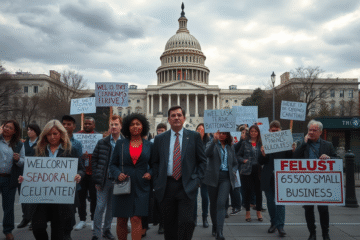Stable Job Market with High Inflation
Job Market The US economy shows remarkable stability in September, with hiring and layoffs remaining under control.
In this article, we will explore how this stability relates to current monetary policy, which takes a cautious 'meeting by meeting' approach.
In addition, we will analyze economic growth, which, while promising, presents risks, and how external factors, such as tariffs, impact inflation.
Finally, we'll highlight expectations for the Fed meeting and the upcoming update on consumer price inflation.
Labor Market Stability in September
The labor market in the United States has shown a period of cautious stability in September, marked by a scenario of few hires and limited layoffs.
This panorama indicates that, despite initial expectations, the American economy is following a path slightly firmer than anticipated, according to information provided by financial institutions.
This occurs in a context where the monetary policies adopted consider the challenges of the labor market, and simultaneously deal with inflation above the 2% target.
During this period, the economy created 254 thousand jobs, numbers that were a positive surprise, exceeding analysts' expectations, according to the CNN Brasil – Job Creation in the US.
However, the unemployment rate increased slightly, reaching 4.3%, signaling that the balance between supply and demand for labor still needs adjustments.
O conservative character of hiring decisions is evidenced by the following list of trends:
- Modest hiring
- Layoffs contained
This business behavior is reflected in the relevance of current monetary policy, with the Federal Reserve adopting a 'meeting by meeting' approach.
Future strategies will depend on economic updates, such as consumer price inflation on October 24, directly influencing interest rate adjustment decisions at the meeting scheduled for the end of the month.
The Fed's 'Meeting by Meeting' Strategy
The Federal Reserve's monetary policy strategy known as meeting by meeting has become essential in the current economic climate in the United States.
With an economy showing signs of strength but still facing challenges, the Fed chooses to assess economic conditions at each meeting before taking new actions.
This approach is based on the mission to assess the weakness of the labor market, which records low hiring and firing rates, and combine this factor with inflation, which remains above the 2% target.
Fed Chairman Jerome Powell emphasizes that balancing supply and demand in the labor market is a priority.
According to a Fed document, this dynamic aims not only to contain the high inflation, but also avoid hasty reactions that could destabilize the financial market.
The practice of adjusting interest rates, adjusted meeting by meeting, is a calculated response to the most recent economic data, with additional cuts of 0.25 percentage points expected at future meetings.
Adopt a contextual and deliberate stance in each meeting is vital, considering that decisions are based entirely on data such as the labor market numbers and the trajectory of inflation.
This flexibility heats up the debate among Fed directors, as reports point to internal disagreements, but confirms a commitment to the effectiveness of current monetary policy.
Promising Economic Growth and Risks to Monetary Policy
The current scenario in the US reveals a promising economic growth, driven by an increase in economic activity and better projections for the future.
However, in parallel, different risks emerge and make monetary policy a delicate issue.
A crucial factor is persistent inflation, which exceeds the 2% target, challenging the Fed's ability to implement interest rate cuts as expected.
Learn more about the Fed's expectations regarding this growth.
| Risk | Effect |
|---|---|
| Persistent inflation | Limits cuts |
| Uncertain job market | Increases volatility |
| Trade tensions | Impacts forecasts |
| Tariff charges | Pressures prices |
The labor market also remains a point of attention, with few hirings and layoffs in September, highlighting the need for a monetary policy that is adapted 'meeting by meeting'.
To ensure that this promising economic growth persists, the Fed needs to constantly monitor economic data and adjust its strategies.
Such an approach is necessary even though the economy appears to be on a slightly firmer path than expected, as warned by Powell.
High Inflation: Tariffs Versus Broad Pressures
A high inflation in the United States is a topic of great concern, mainly due to the tariffs recently imposed that directly impact the prices of consumer goods.
Federal Reserve Chairman Jerome Powell highlighted that much of this increase is a direct result of these tariffs, which create trade barriers, raising the cost of imported goods. read more here.
These barriers, by making foreign products more expensive, put pressure on the domestic market to increase prices to compete, resulting in a high inflation.
In contrast, the broad inflationary pressures are more difficult to control because they relate to macroeconomic dynamics, such as robust economic growth or significant wage increases, not just political factors such as tariffs.
The exact understanding of how each factor individually affects inflation is crucial for the Fed to adapt its monetary policies appropriately.
Currently, these policies are defined meeting by meeting, reflecting the urgency of responding quickly to changes in the economic landscape.
With updates expected, including on consumer prices, the Fed will seek a careful balance between encouraging growth and containing high inflation, especially in times of global economic uncertainties.
October Key Dates and Possible Interest Rate Cut
In October, the focus is on updating the consumer inflation scheduled for the 24th, which will be decisive for the meeting of October 28-29 of the Federal Reserve.
That meeting, already anticipated by experts, discusses a new cut in the interest rate of 0.25 percentage points.
Second Infomoney projections, the decision will have major economic implications.
Inflation, although high, is not due to broad inflationary pressures, but rather tariffs.
Economic uncertainty demands a careful approach from the Fed, which makes analyzing inflation data even more crucial to determining the safest path.
During the meeting of October 28-29, to the options will be assessed considering the more stable economic scenario.
If the interest rate cut is confirmed, we may see market effects such as:
- Credit stimulus, facilitating loans
- Consumer support through spending incentives
- An eventual increase in economic growth
In short, labor market stability and inflationary challenges require constant vigilance of monetary policy.
The next Fed meeting will be crucial in defining the direction of the American economy.



0 Comments